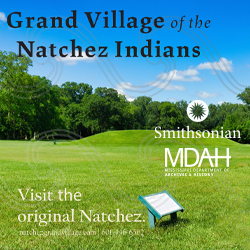Rising high above the Delta flatlands all along the length of our river border, more than 30 significant mound sites on the Mississippi Mound Trail offer a peek back through history. For millennia before European settlers arrived, Native American tribes constructed mounds throughout the Mississippi River Valley. These sites marked locations of religious, social and political significance, and some served as the earthen foundation for the homes of respected elders.
Within the borders of Mississippi as we know it today, indigenous peoples built mounds throughout the Plaquemine Mississippian period, or from 1200 to 1650 AD, although archaeological digs have revealed evidence of settlements from the Coles Creek period, which began in 650 AD, at some mound sites. Excavations of mounds beginning in the 20th century have revealed burial sites and the remains of domestic habitations, such as pottery and remnants of living quarters.
Just North of Greenville, the Winterville mounds are the largest in the state, with a centerpiece rectangular platform measuring 55 feet high. At one time, the site included 20 mounds, many of which supported architecture—and in some cases, structures that were burned and rebuilt repeatedly over time. The Winterville mounds are recognized as a National Historic Landmark.
The sight of a grand Colonial revival mansion perched high above the flat Delta is certainly jarring after driving through miles and miles of farmland. At Mont Helena, located near Rolling Fork in the middle of a field, is one of the more mysterious mounds in the state. Only four artifacts have been recovered from the site, and some assume it was used as a ceremonial mound. The current height of 26 feet is at least 10 feet lower than its original height; that much was removed before the home was built in 1896. The home is now open for tours.
As the first permanent European settlement in the Mississippi River Valley, we know quite a bit more about the mounds at Grand Village of the Natchez Indians. That’s because when a French explorer first mapped the site in 1723, four of the six mounds were still in use. Grand Village was the center of the Natchez chiefdom and home to leaders including Great Sun and Tattooed Serpent. One of three remaining mounds, identified on French maps as the home of Great Sun, was confirmed by archaeologists following excavations in the 1960s. Today, visitors can tour a replica of a Natchez native dwelling and view artifacts retrieved from archaeological digs at the onsite museum.



